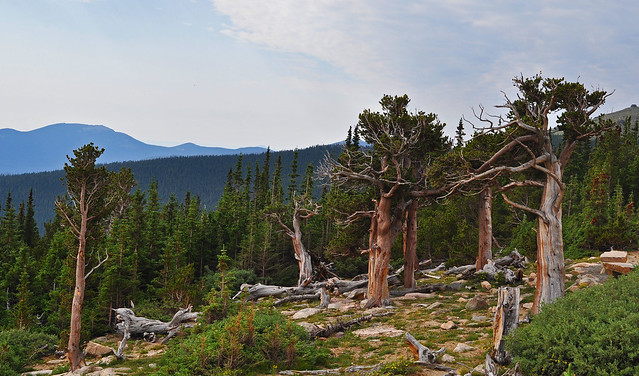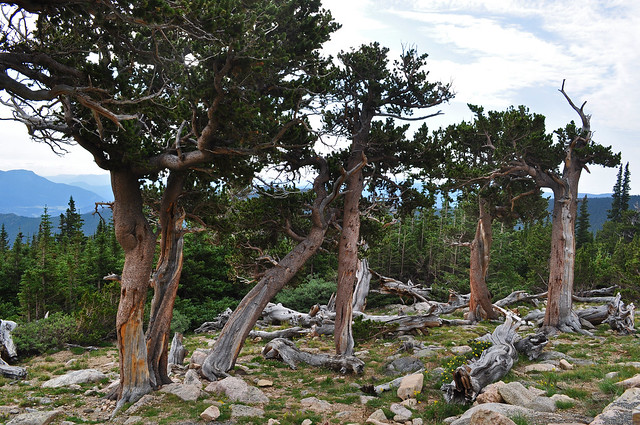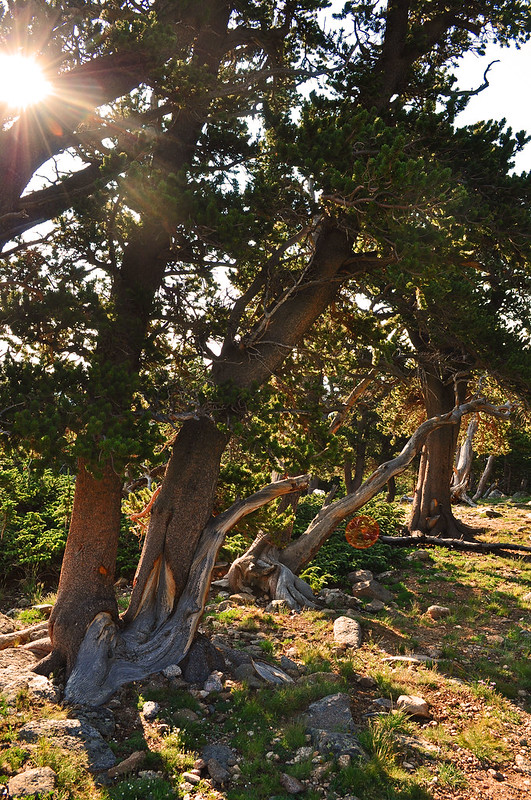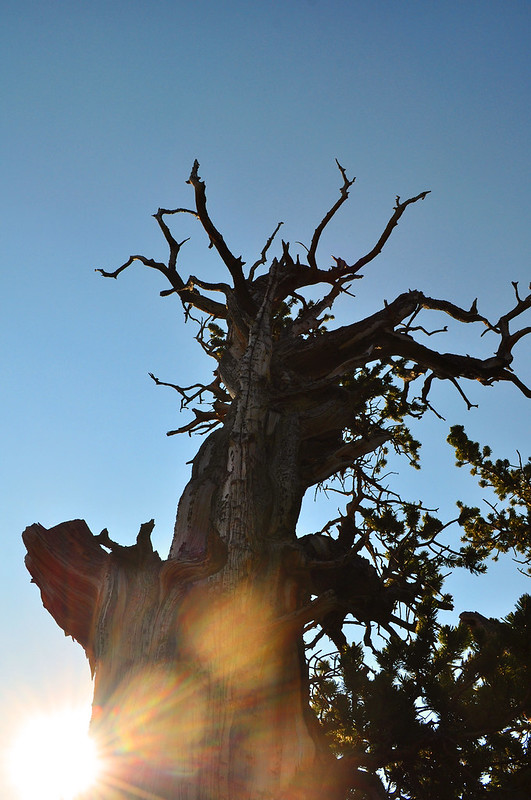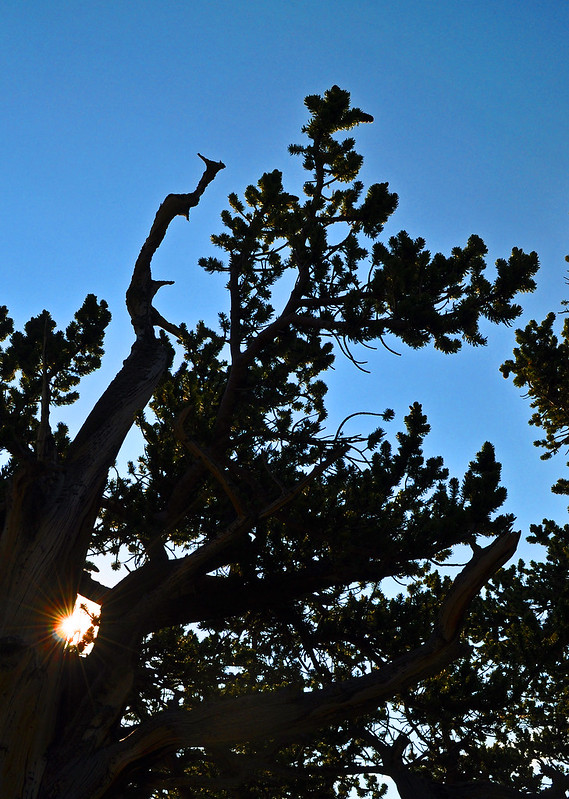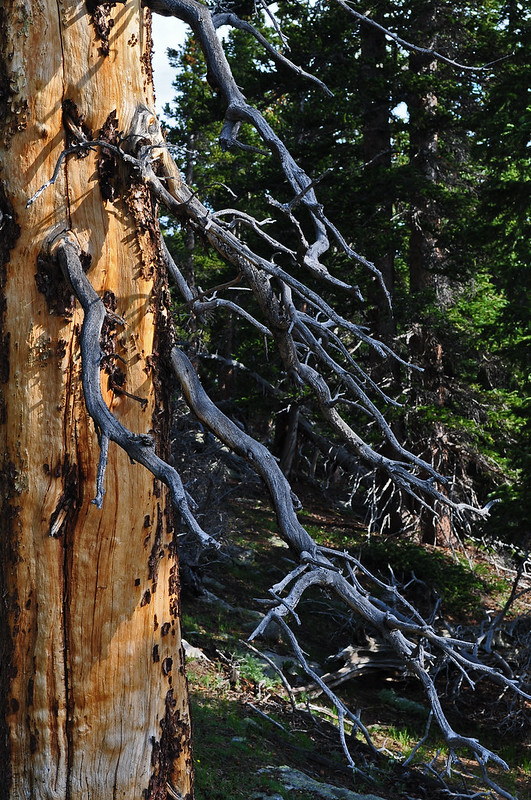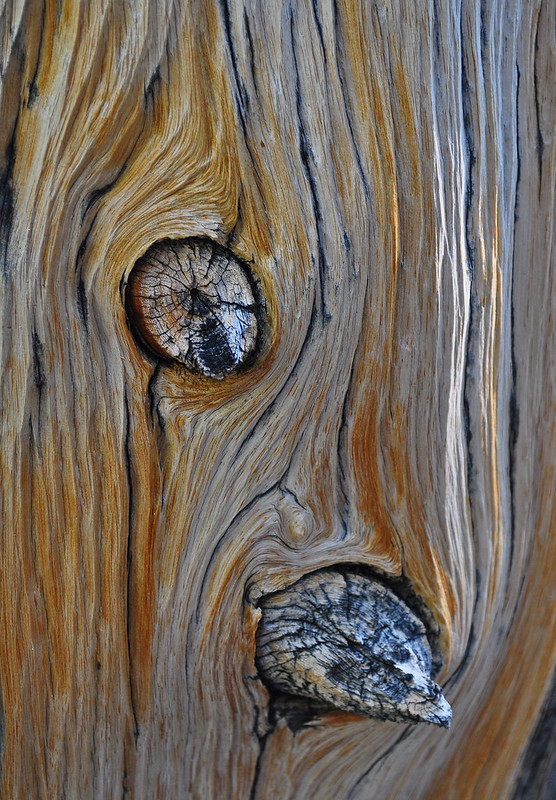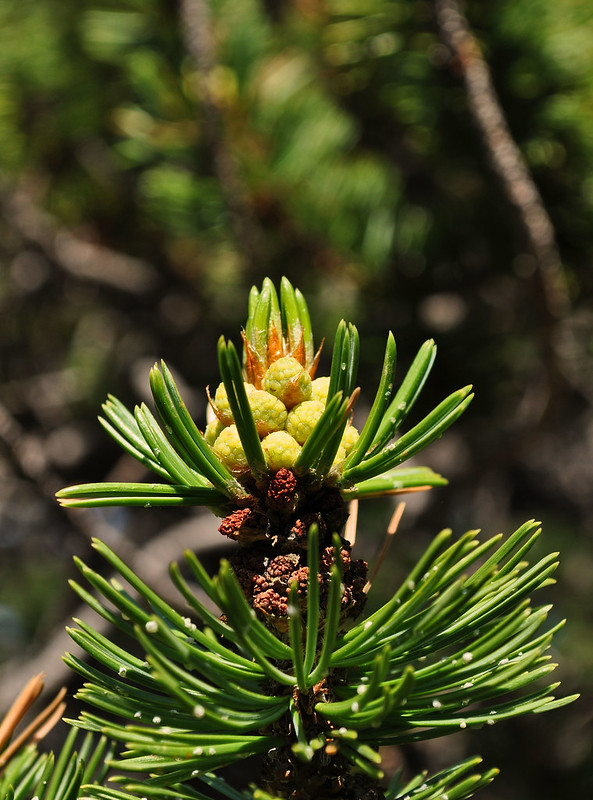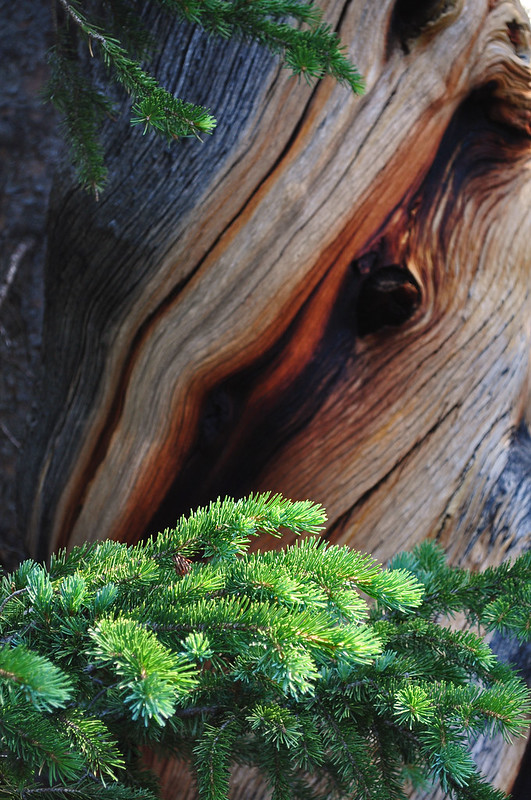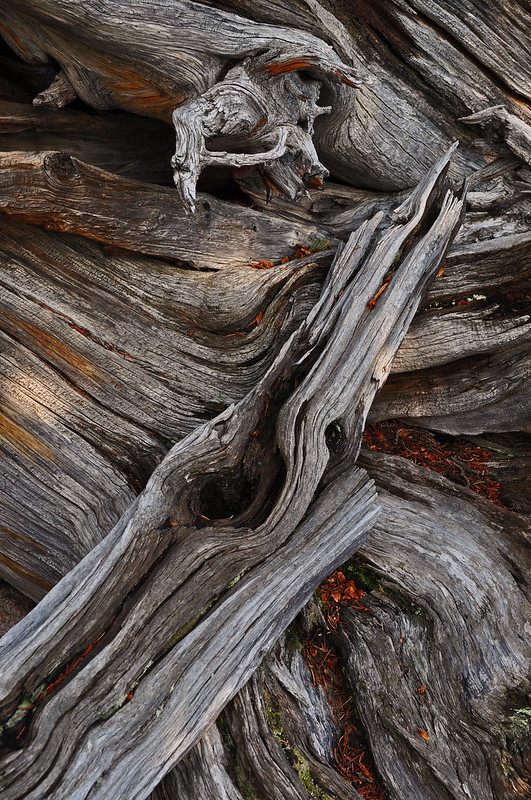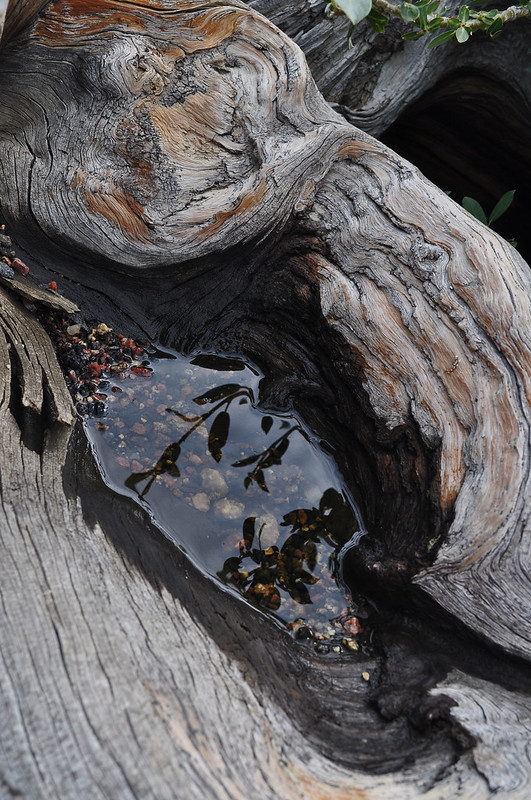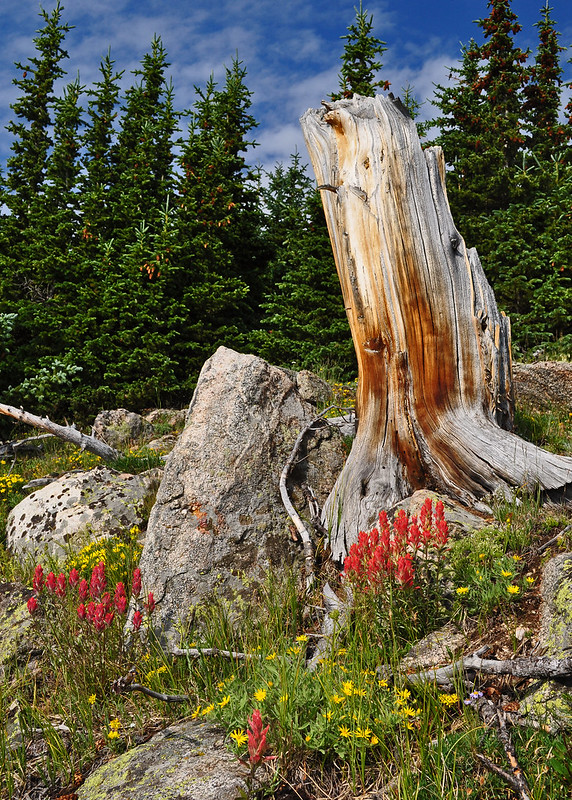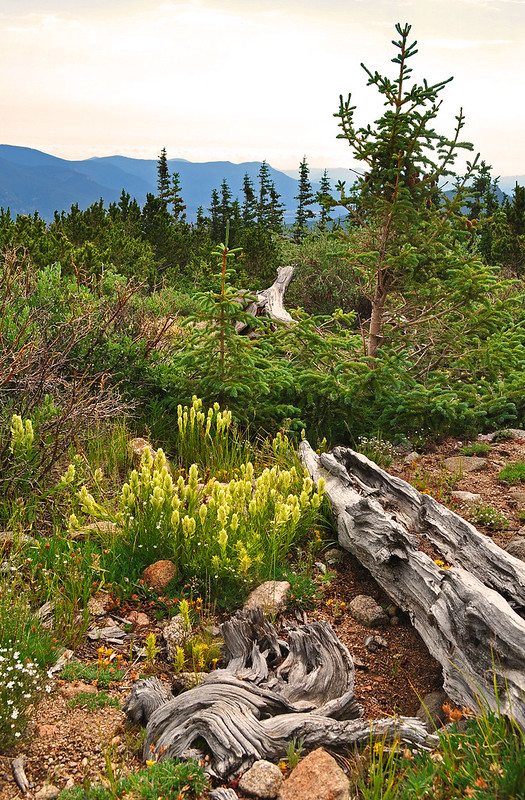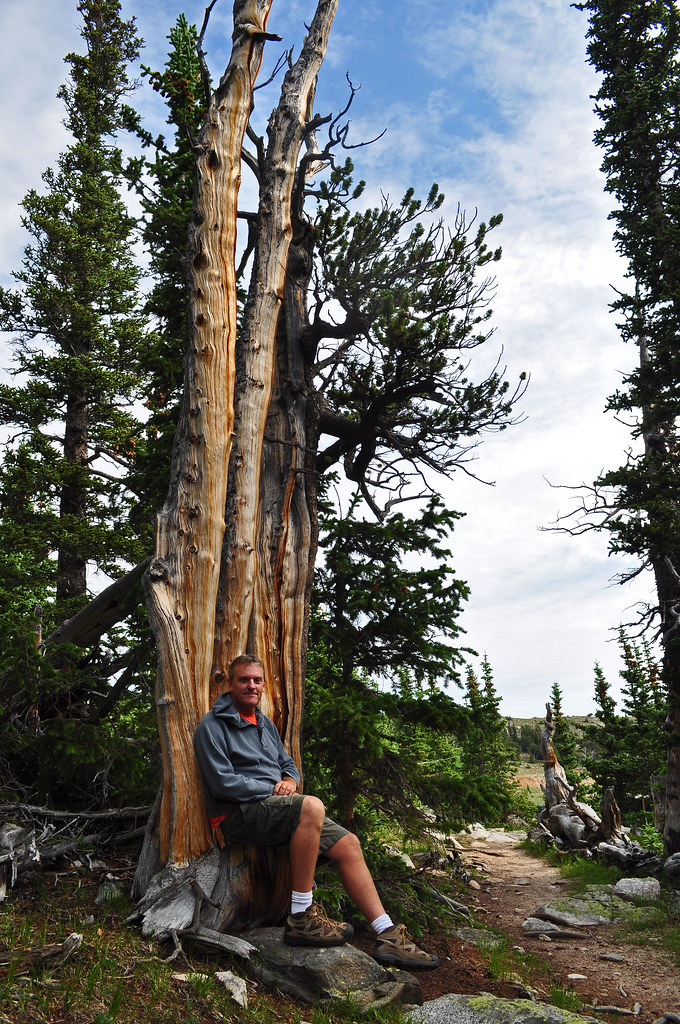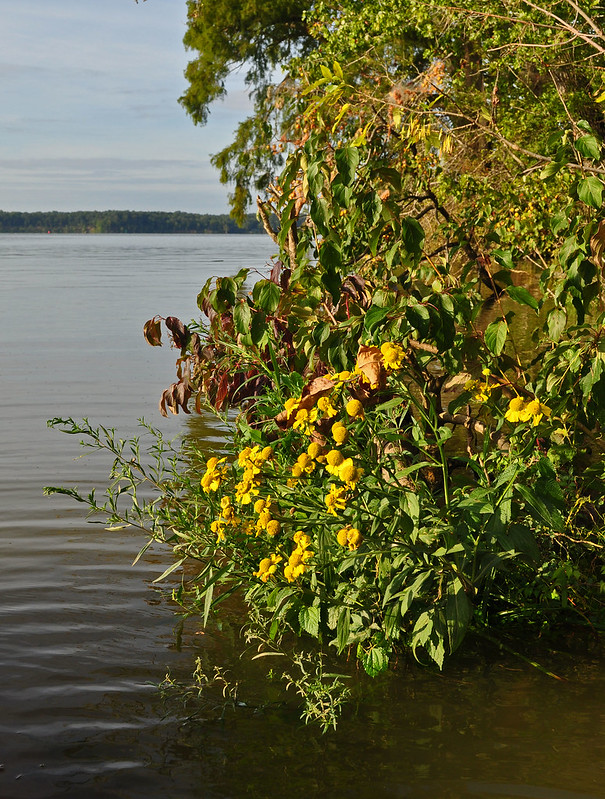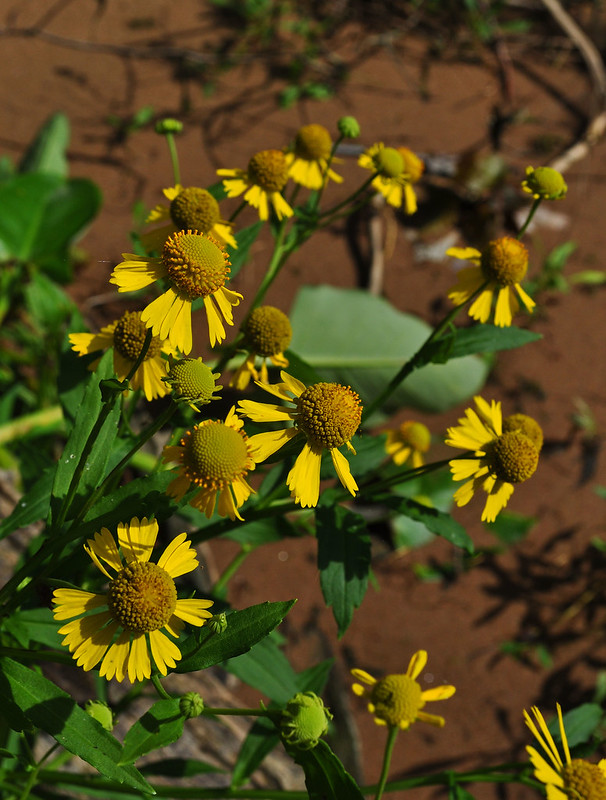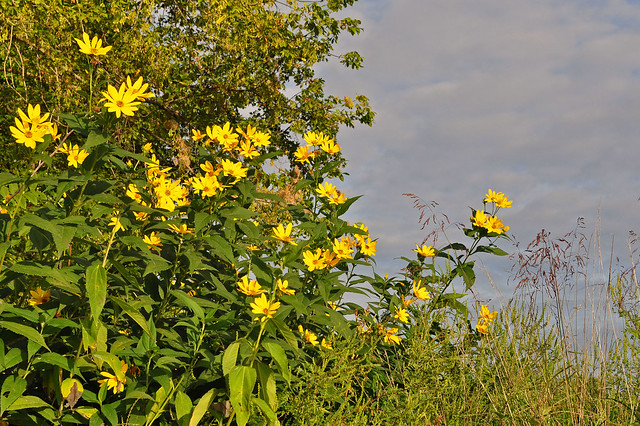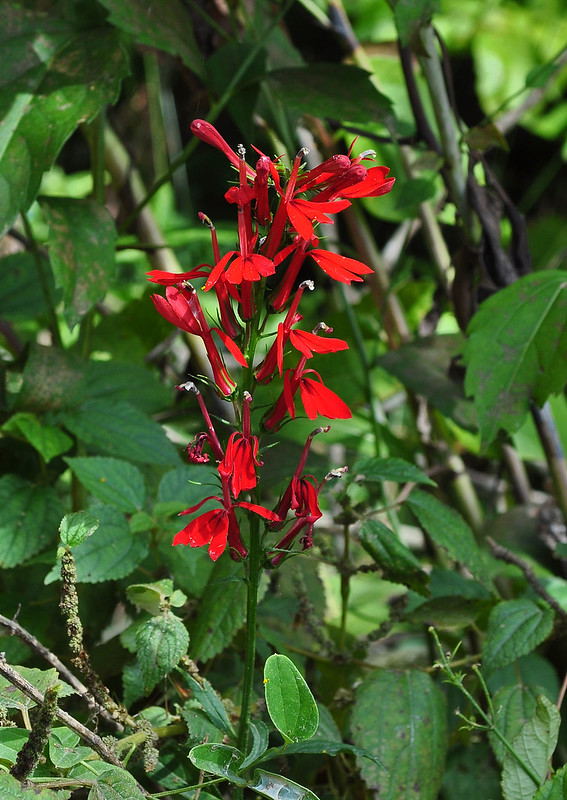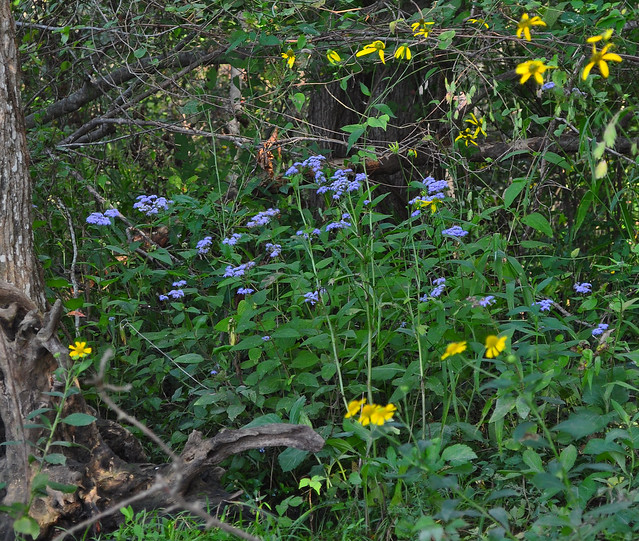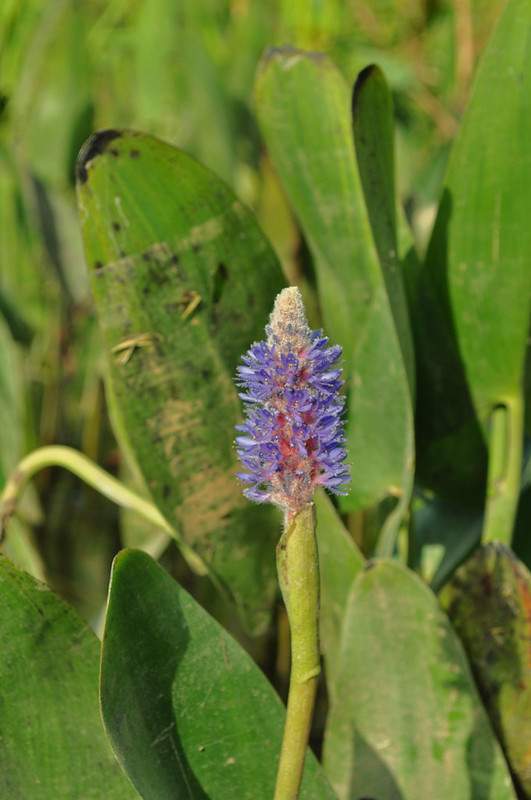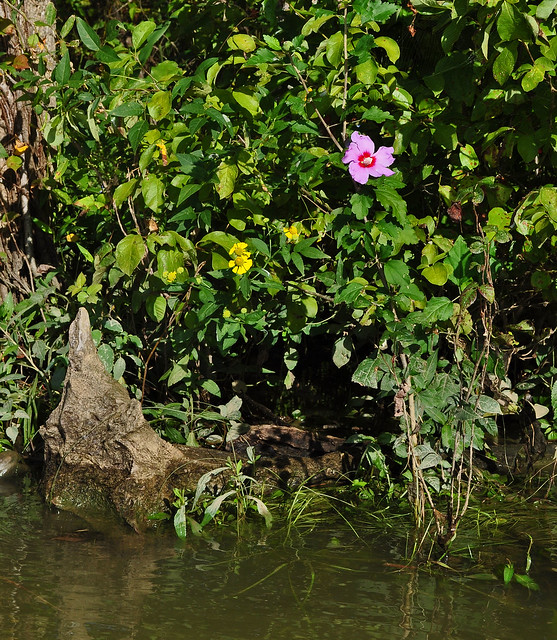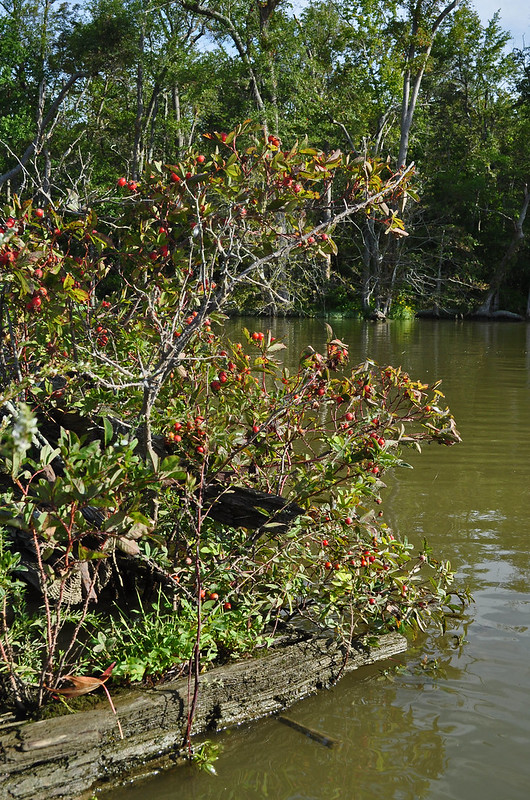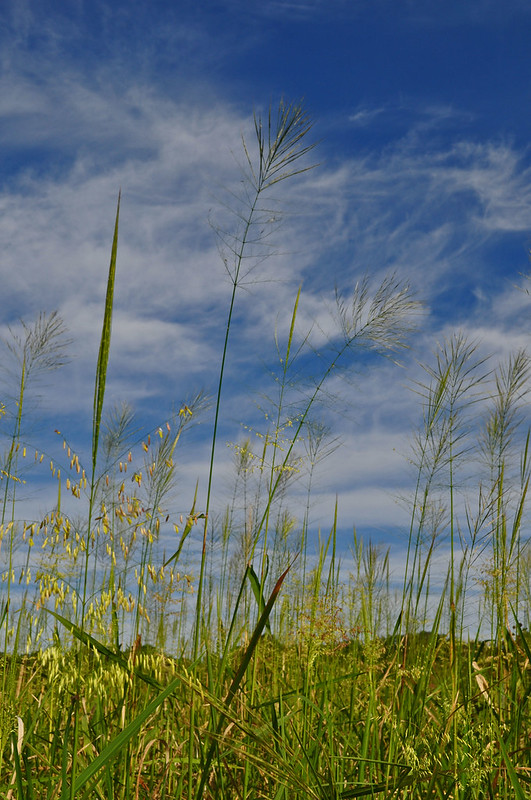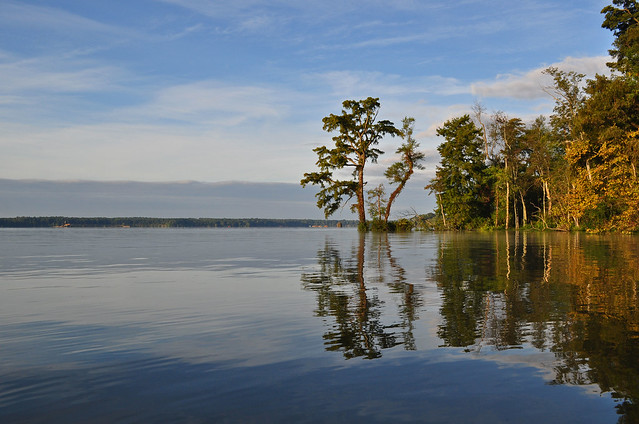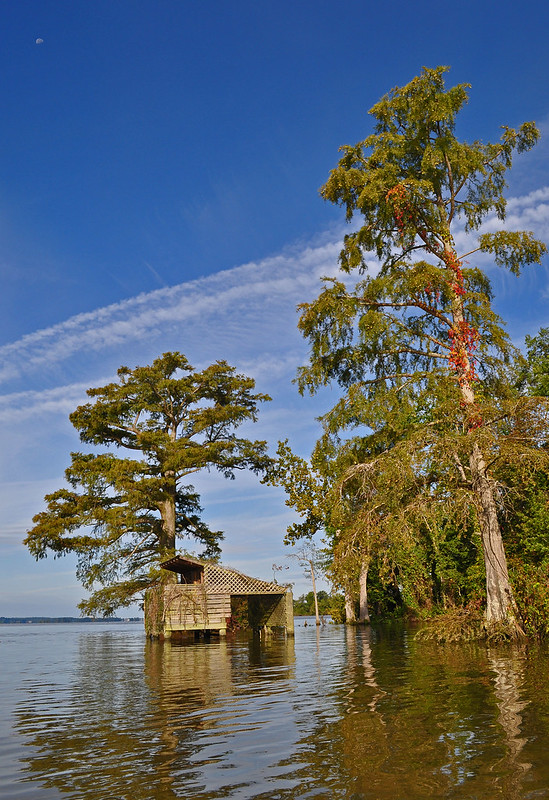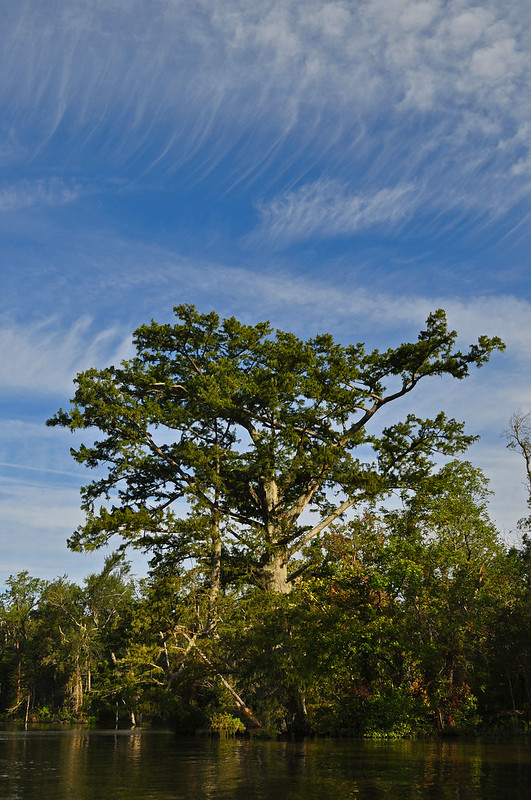September 27, 2014
Among the Ancients
On our trip to Colorado this summer, one of the places I really wanted to visit again was the Mt. Goliath Natural Area. We briefly stopped here on our first trip west, but I was alone in wanting to spend more time here and felt rushed, plus I did not own a decent camera then. This summer there was no rush, and Sherpa Girl K and I were able to wander leisurely among the bristlecone pines (Pinus aristata). Some of these wonderfully gnarled trees are between 1000 and 1600 years old, which given my own species' record of stewardship on this planet, it is totally remarkable that these plants are still able to survive. The natural area has a small visitors center where you can learn more about the surrounding environment, and immediately outside, native wildflowers are showcased in an alpine garden, but it was the pines I came to see.
Bristlecones are extremely well adapted to their environment, which is quite harsh. The soils are thin, rocky and poor, the winter temperatures are brutally cold, the rain is sparse, but the wind is not, and this high up the sun's radiation is intense. The trees have adapted by growing very, very slowly, making the wood dense, strong and resistant to diseases, insects, rot and bacteria. Each needle can last close to 20 years, minimizing the amount of energy needed to produce new growth. The gnarled and twisted trunks make the trees more resistant to the strong winds. The large amount of dieback on the bark and in the xylem layer reduces the need for moisture and nutrients when the trunks have been damaged by drought or fire. The relatively large distance between specimens helps keep fire from spreading when one of the pines has been hit by lightening. Even when one does die, it can take many decades for the ghost tree to finally fall to the forest floor.
I would love to know what this tree was trying to tell us, but the alphabet was not familiar.
If you haven't had your fill, my complete set of photos from my morning at Mt. Goliath can be seen here, at my flickr page, and while you are looking at them, do so trying to imagine the feel of cool crisp air, and the smell of fresh Christmas trees.
Labels:
Colorado,
Hiking Trails,
Making Time for Church
September 21, 2014
Hurricane Hugo 1989
Once upon a time, a young man was supposed to meet some friends for a long weekend at a beach house in North Carolina. However, he was given the wrong address, and in those days there were no such things as cell phones, and he had no way to find his friends. So what was the young man to do? He certainly didn't want go back to gray Richmond, rather he headed further south to Charleston, a place that he had always imagined he would like, and indeed he did, so much so, he decided that very weekend to make his home there. He loved Charleston's architecture, the ghosts of its history, its Gothic atmosphere, and its beaches, but he especially loved the Lowcountry. In places he felt that the landscape of palmetto, marsh, and live oaks dripping with Spanish moss still held some of the earth's original magic, and this feeling startled his usually cynical self.
Being an innkeeper by trade, the young man had no trouble finding employment, and as soon as he secured a position, moved himself to one of the sea islands just outside the city. For the next three years he made many good friends, learned the area's stories, grew fat on shrimp, and explored the Carolina countryside. It was a wonderful life. Then a disturbance from the west African coast, later to be named Hugo, appeared on the radar, and he was overcome with a premonition of dread and inevitability. As the storm neared, he and his fellow citizens pleaded with the gods to spare the beautiful city. Perhaps Hugo could take Myrtle Beach instead. The pleas were for naught, and at the last minute he was forced to evacuate his island home, heading inland in a car full of dogs and one brave cat. The night Hugo hit was spent huddling with others in a Columbia hallway as tornadoes swirled outside. It was the longest night of the young man's life. Two days later he and his fellow evacuees made the long drive back to the coast, where it quickly became apparent that the place he had come to love seemed to have been forever changed.
Although the destruction was vast, the young man's home was spared but for minor water damage and the loss of utilities, so he moved back in. He was also fortunate to still have employment, and spent the next few months inspecting hotel rooms, condos, villas and houses for hurricane damage. Despite his good fortune, he couldn't bare looking at what had happened to Charleston and the Lowcountry, and with heavy heart decided to leave the place. He would prefer to keep his memories of the time before, and to not have splintered trunks, missing buildings, and mountains of rubble be constant reminders of the time after. Though given the opportunity, in the years that followed he chose not to return, but in time his now middle aged life found him back again for several visits. It did his heart good to see how the trees had grown, and how the city had not only healed, but was more vibrant than ever. To him it was almost as if the storm had never happened, and was just one more thing the city had survived, another page in its history book to accompany the British siege, the Union bombardment, the great earthquake, the tornadoes, and being discovered by the outside world.
Being an innkeeper by trade, the young man had no trouble finding employment, and as soon as he secured a position, moved himself to one of the sea islands just outside the city. For the next three years he made many good friends, learned the area's stories, grew fat on shrimp, and explored the Carolina countryside. It was a wonderful life. Then a disturbance from the west African coast, later to be named Hugo, appeared on the radar, and he was overcome with a premonition of dread and inevitability. As the storm neared, he and his fellow citizens pleaded with the gods to spare the beautiful city. Perhaps Hugo could take Myrtle Beach instead. The pleas were for naught, and at the last minute he was forced to evacuate his island home, heading inland in a car full of dogs and one brave cat. The night Hugo hit was spent huddling with others in a Columbia hallway as tornadoes swirled outside. It was the longest night of the young man's life. Two days later he and his fellow evacuees made the long drive back to the coast, where it quickly became apparent that the place he had come to love seemed to have been forever changed.
Although the destruction was vast, the young man's home was spared but for minor water damage and the loss of utilities, so he moved back in. He was also fortunate to still have employment, and spent the next few months inspecting hotel rooms, condos, villas and houses for hurricane damage. Despite his good fortune, he couldn't bare looking at what had happened to Charleston and the Lowcountry, and with heavy heart decided to leave the place. He would prefer to keep his memories of the time before, and to not have splintered trunks, missing buildings, and mountains of rubble be constant reminders of the time after. Though given the opportunity, in the years that followed he chose not to return, but in time his now middle aged life found him back again for several visits. It did his heart good to see how the trees had grown, and how the city had not only healed, but was more vibrant than ever. To him it was almost as if the storm had never happened, and was just one more thing the city had survived, another page in its history book to accompany the British siege, the Union bombardment, the great earthquake, the tornadoes, and being discovered by the outside world.
 |
| Downtown Charleston |
 |
| Near St. Matthews Lutheran Church |
.jpg) |
| North Market St. |
.jpg) |
| North Market St. |
 |
| 2nd Presbyterian Church |
 |
| Churchyard Wall |
.jpg) |
| Brittlebank Park |
 |
| Brittlebank Park |
.jpg) |
| Hampton Park |
.jpg) |
| Hampton Park |
.jpg) |
| James Island |
 |
| James Island |
 |
| Johns Island |
 |
| Iggly Wiggly, Johns Island |
.jpg) |
| Kiawah Island |
.jpg) |
| Kiawah Island |
.jpg) |
| Kiawah Island |
.jpg) |
| Kiawah Island |
.jpg) |
| Kiawah Island |
 |
| National Guard Troops, Marion Square |
Labels:
Anniversary,
Events,
Fun with Photography,
Off Topic,
South Carolina
Location:
Charleston County, SC, USA
September 15, 2014
Bloom Day - River Flowers
With few exceptions, my September blooms look a lot like my August blooms, so feeling pressed for time, and wanting to do something different, this month's Bloom Day will feature some of the plants I saw yesterday while kayaking along the James River in Charles City County, Virginia. This part of the river is about halfway between Williamsburg and Richmond, and is far enough from the coast that the water is mostly fresh, which changes the plant palette I normally see when I paddle.
The most abundant flower I saw was Helenium autumnale. Its common name is sneezeweed, which is not very endearing, but it came not from anything to do with alergens, but from the fact it was once used as snuff. The species was so numerous, a nearly continuous band of yellow wrapped the shoreline.
Helenium was not the only yellow flower on the shore. Helianthus tuberosus (Jerusalem artichoke) was blooming, as well as...
Rudbeckia laciniata (cutleaf coneflower).
Not all the blooms were yellow. Lobelia cardinalis (cardinal flower) was still showing a little red, despite being at the end of its season.
Conoclinium coelestinum (blue misflower)
Pontideria cordata (pickerel weed)
One flower I did not expect to see was Hibiscus syriacus (althea, rose of Sharon). With the exception of the newer, sterile cultivars, this plant has a reputation for seeding around the garden, but I saw several growing along the bank, far from any garden bed.
Rosa palustris (swamp rose)
There were acres and acres of wild rice (Zizania aquatica var. aquatica) growing in the vast marshes. The seeds were just starting to ripen, and years ago would have been an important crop for the local native Americans.
The plant I enjoyed the most along the river had no blooms at all, but it is one of my favorite trees, Taxodium distichum (bald cypress). Any time I can paddle among these giants is a good time.
Bloom Day is held on the 15th of each month, and is hosted by Carol at May Dreams Garden. If you pay her a visit, please tell her I said thank you, and that I apologize for bending the rules, yet again.
(A different account of this trip is available at my kayaking blog, A Tidewater Paddler, and all of the photos can be seen on my Flickr page.)
The most abundant flower I saw was Helenium autumnale. Its common name is sneezeweed, which is not very endearing, but it came not from anything to do with alergens, but from the fact it was once used as snuff. The species was so numerous, a nearly continuous band of yellow wrapped the shoreline.
Helenium was not the only yellow flower on the shore. Helianthus tuberosus (Jerusalem artichoke) was blooming, as well as...
Rudbeckia laciniata (cutleaf coneflower).
Not all the blooms were yellow. Lobelia cardinalis (cardinal flower) was still showing a little red, despite being at the end of its season.
Conoclinium coelestinum (blue misflower)
Pontideria cordata (pickerel weed)
One flower I did not expect to see was Hibiscus syriacus (althea, rose of Sharon). With the exception of the newer, sterile cultivars, this plant has a reputation for seeding around the garden, but I saw several growing along the bank, far from any garden bed.
Rosa palustris (swamp rose)
There were acres and acres of wild rice (Zizania aquatica var. aquatica) growing in the vast marshes. The seeds were just starting to ripen, and years ago would have been an important crop for the local native Americans.
The plant I enjoyed the most along the river had no blooms at all, but it is one of my favorite trees, Taxodium distichum (bald cypress). Any time I can paddle among these giants is a good time.
Bloom Day is held on the 15th of each month, and is hosted by Carol at May Dreams Garden. If you pay her a visit, please tell her I said thank you, and that I apologize for bending the rules, yet again.
(A different account of this trip is available at my kayaking blog, A Tidewater Paddler, and all of the photos can be seen on my Flickr page.)
Labels:
Bloom Day,
Fun On the Water
Location:
Charles City County Courthouse, VA, USA
Subscribe to:
Posts (Atom)
